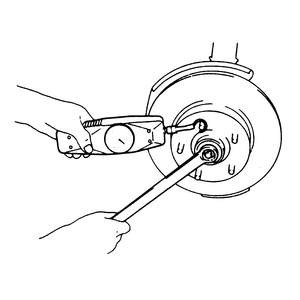NOTE: Front wheel bearing preload adjustment is not required
on the 929, but make sure that you check the end-play, as previously described.
- Raise the front end and safely support it on jackstands.
- Remove the front wheel.
- Remove the grease cap from the wheel hub. This can usually be done by
prying between it and the wheel hub with a flat blade screwdriver. Be careful
not to bend or gouge the cap.
- Wipe some of the grease away, then remove and discard the cotter pin in
the end of the spindle. Remove the nut lock.
- Remove the disc brake caliper with the brake hose attached, and secure
it to the strut spring with wire or twine.
- Torque the adjusting nut to 14–18 ft. lbs. (19–24 Nm), then
rotate the brake disc to seat the bearings.
- Back off the adjusting nut about 1⁄6 of
a turn (approximately 60 degrees).
- Install one hub bolt into the wheel hub to serve as an anchor for the
spring scale.
- Hook a spring scale onto the hub bolt.
- Pull the scale squarely, until the hub just begins to rotate, and note
the reading. The reading should be 0.33–1.32 lbs. (0.15–0.60
kg) for the GLC, or 0.77–1.92 lbs. (0.035–0.87 kg) for the 626.
Tighten the adjusting nut until the proper reading is obtained. Remove the
scale and hub bolt.
- Place the castellated nut lock over the adjusting nut. Align one of the
slots in the nut lock with the hole in the spindle. (If the holes do not
align, tighten the adjusting nut only until the holes align.) Then, insert
a new cotter pin and bend the ends to secure it in place.
NOTE: Always tighten the adjusting nut to its next castellation
to align cotter pin holes of the nut lock and spindle shaft. NEVER loosen
it.
- Repack the grease cap with fresh grease and install on the hub.
- Remove the wire or twine and install the brake caliper assembly.
- Install the wheel.
- Repeat Steps 2–14 for the other front wheel, if necessary.
- Lower the vehicle.
- Raise the front end and safely support it on jackstands.
- Remove the front wheel.
- Remove the disc brake caliper with the brake hose attached, and secure
it to the strut spring with wire or twine.
- Remove the grease cap from the wheel hub. This can usually be done by
prying between it and the wheel hub with a flat blade screwdriver. Be careful
not to bend or gouge the cap.
- Wipe some of the grease away, then remove and discard the cotter pin in
the end of the spindle. Remove the nut lock.
- Install one hub bolt into the wheel hub to serve as an anchor for the
spring scale.
- Tighten the adjusting nut to 18–22 ft. lbs. (24–30 Nm) to
lock the wheel hub, then back off the nut until the wheel hub turns smoothly.
- Rotate the hub back and forth three or four times to seat the bearings,
then hook a spring scale onto the hub bolt.
- Pull the scale at a 90 degree angle and note the reading when the hub
starts to turn. The reading should be 0.99–1.43 lbs. (0.5–0.65
kg).
- Either loosen or tighten the adjusting nut until the scale reads within
the above range, then remove the scale and hub bolt.
- Install the nut lock and insert a new cotter pin through the nut lock
and spindle. (If the holes do not align, tighten the adjusting nut only
until the holes align.)
NOTE: Always tighten the adjusting nut to its next castellation
to align cotter pin holes of the nut lock and spindle shaft. NEVER loosen
it.
- Bend up the ends of the cotter pin to secure it in place.
- Repack the grease cap with fresh grease and install on the hub.
- Remove the wire or twine and install the brake caliper assembly.
- Install the wheel.
- Repeat Steps 2–15 for the other front wheel, if necessary.
- Lower the vehicle.
- Raise the front end and safely support it on jackstands.
- Remove the front wheel.
- Remove the disc brake caliper assembly and secure it to the strut spring
with wire or twine.
- Remove the grease cap, cotter pin and set cover (nut lock). Discard the
cotter pin.
| Fig. 1: Adjusting front wheel bearing preload using
a spring scale

|
- Loosen the hub nut.
- Using a torque wrench, tighten the hub nut to 14–22 ft. lbs. (19–30
Nm). Turn the wheel hub two or three times to seat the bearing.
- Loosen the hub nut again until it is finger-tight.
- Connect a spring scale to one of the lug bolts. Pull on the spring scale
at a 90 degree angle and measure the frictional force that is required to
turn the wheel. The force (preload) should be 0.9–0.22 lbs. (0.4–1.0
kg).
- Tighten the hub nut in small amounts until the reading on the scale is
within the range, then remove the scale.
- Position the set cover and secure it with a new cotter pin. (If the holes
do not align, tighten the hub nut only until the holes align.)
NOTE: Always tighten the adjusting nut to its next castellation
to align cotter pin holes of the nut lock and spindle shaft. NEVER loosen
it.
- Repack the grease cap with fresh grease and install on the hub.
- Remove the wire or twine and install the brake caliper assembly.
- Install the wheel.
- Repeat Steps 2–13 for the other front wheel, if necessary.
- Lower the vehicle.



